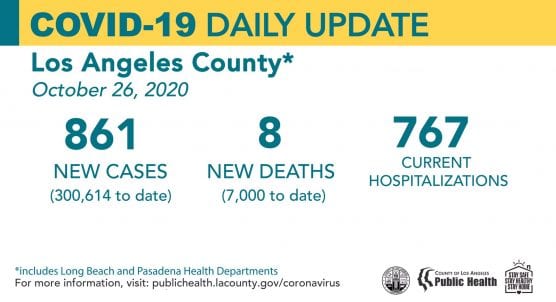The Los Angeles County Department of Public Health on Monday confirmed 8 new deaths and 861 new positive cases of COVID-19 in the past 24 hours, with 136 new cases reported in the Santa Clarita Valley since Friday.
The number of new cases and deaths reflects a reporting lag over the weekend, according to Public Health officials.
The SCV has now had a total of 7,136 confirmed COVID-19 cases and 73 deaths from the virus since the World Health Organization declared the pandemic on March 11.
L.A. County has reached the grim milestone of 7,000 confirmed COVID-19 deaths and 300,614 positive cases of COVID-19 across all areas of the county to date.
“Today marks another tragic milestone as 7,000 L.A. County residents have passed away from COVID-19,” said Barbara Ferrer, PhD, MPH, MEd, Director of Public Health. “We report these numbers each day understanding how many people across our community are grieving someone who has passed away from COVID-19. To all of you, we send our deepest sympathies.”
Upon further investigation, seven cases and one death reported earlier were not county residents.
There are 767 people currently hospitalized with COVID-19 countywide, and 29% of them are in the ICU.

Public Health notes children of all ages have been hospitalized for COVID-19 and even though the likelihood of hospitalization among children remains very low across all age groups, there was a gradual upward trend in hospitalizations among all age groups from April through mid-September.
The largest increases were among children ages 12 through 17 years old that occurred in late August and mid-September, likely a result of the summer’s spike in cases.
Test results are available for more than 3,020,000 county residents, with 9% of all people testing positive.
See more L.A. County info later in this report.

California Monday Snapshot
Statewide, as of Sunday, October 25, the California Department of Public Health confirmed a total of 901,010 COVID-19 cases (up 2,981, with 17,357 deaths from the disease (up 12).
There are 2,281 confirmed hospitalizations and 633 ICU hospitalizations in the state, a slight downward trend.
California’s 7-day positivity rate is 3.2% and the 14-day positivity rate is 2.8%, continuing a slight upward trend.
As of October 25, local health departments have reported 43,663 confirmed positive cases in healthcare workers and 200 deaths statewide.
There have been 17,982,829 COVID-19 tests conducted in California, an increase of 194,944 over the prior 24-hour reporting period.
Numbers do not represent true day-over-day change as these results include cases from prior to yesterday.
See more California info later in this report.

This graph shows the daily new reported COVID-19 cases in the United States since the pandemic began as of Sunday, October 25, 2020. | CNBC graph based on data from the Johns Hopkins University COVID tracker.
COVID U.S.A.: Record Daily Cases, Rising Hospitalizations
Since the pandemic began, more than 8,687,289 Americans have been diagnosed with COVID-19, while the number of people in the U.S. who have died due to the virus has surpassed 225,580.
The U.S., with 4.25% of the world’s population and more than 20% of the confirmed cases, also continues to lead the world in deaths.
By comparison, No. 2 Brazil’s death toll is 157,134. India, at No. 2 in cases, had confirmed 7,909,959 cases and 119,014 deaths as of Monday afternoon.
Henry Mayo Newhall Hospital Monday Update
Henry Mayo releases statistics weekly, generally on Wednesdays, unless there is a drastic change in the number of cases or a COVID-related death has been confirmed, spokesman Patrick Moody said.
As of Wednesday, October 21, of the 9,693 people tested at Henry Mayo to date, 997 tested positive, 11,486 were negative, 44 were pending, 12 patients were hospitalized in a dedicated unit receiving ICU-level care, and a total of 290 COVID-19 patients have been treated and discharged so far.
The number of people who have died of COVIF-19 at Mayo Mayo stood at 30, Moody said. Privacy laws prohibit the hospital from releasing the community of residence for patients who die.
Discrepancies in the testing numbers are due to some patients being tested multiple times. “Often a single patient is tested more than once,” he said.

Santa Clarita Valley Monday Update
As of 8 p.m. Saturday, October 24, the latest update to its COVID-19 data dashboard, L.A. County Public Health reported 73 deaths in the Santa Clarita Valley since the pandemic began.
Of the 73 SCV residents who have died to date, 61 lived in the city of Santa Clarita (adjusted from 60 previously reported), 4 in Castaic (adjusted from 5 previously reported), 2 in Acton, 3 in Stevenson Ranch, 1 in unincorporated Bouquet Canyon, 1 in Val Verde, and 1 in unincorporated Valencia.
Of the 7,136 confirmed COVID-19 cases reported to Public Health for the SCV to date, the community breakdown is as follows:
City of Santa Clarita: 4,219
Castaic: 2,176 (includes Pitchess Detention Center and North County Correctional Facility*)
Stevenson Ranch: 197
Canyon Country (unincorporated portion): 172
Val Verde: 103
Acton: 83
Valencia (unincorporated portion west of I-5): 52
Agua Dulce: 31
Saugus (unincorporated portion): 36
Newhall (Unincorporated portion): 26
Bouquet Canyon: 10
Saugus/Canyon Country: 11
Elizabeth Lake: 8
Sand Canyon: 7
Lake Hughes: 5
*Note: The county is unable to break out separate numbers for Castaic and PDC/NCCF because the county uses geotagging software that cannot be changed at this time, according to officials. Click here for the LASD COVID-19 dashboard.

Episode Date Data Confirm Increase in L.A. County Cases
Last week, L.A. County Public Health experienced reporting system issues, first seeing low case numbers followed by high case numbers. Because of differences in test processing times and reporting lags, the new cases we announce daily are likely collected over several days and sometimes include backlogs of test results.
To understand community spread, the department also tracks cases using the episode date associated with each case record. The episode date is usually the date the test was taken.
The numbers by episode date confirm an increase in cases across L.A. County.
Since the beginning of October, cases have increased from around 940 new cases per day to, as of last week, almost 1,200 new cases per day. This increase, while not as steep as seen in July, is cause for concern.
Large Public Gatherings Contribute to Community Spread
“This pandemic has forced so many to sacrifice so much this year, and we recognize the frustration and disappointment with restrictions on large gatherings, celebrations and events,” Ferrer said.
“For now, it is simply not safe to celebrate the way we usually do,” she said.
“Being close to others not in our household carries with it a lot of risk for transmitting COVID-19, so it remains necessary to modify activities to be as safe as possible,” Ferrer said. “So many businesses have done their very best to open in ways that reduce exposure to the virus for customers and staff. Schools are carefully creating environments that allow for as much safety as possible for on-site support, and residents continue to take to heart our personal, individual responsibility to slow the spread of COVID-19. We thank you for your diligence since we need to continue using every tool we have to slow the spread of the virus.”
Halloween Celebration Guidance Update
Public Health advises residents to celebrate Halloween as safely as possible. Trick-or-treating and trunk or treating are not safe during a pandemic, and the county strongly recommends that you not participate in these activities since they carry the risk of increased exposure to the virus through crowding, mixing with non-household individuals, and communal food handling.
Instead, participate in a virtual party, take a walk (socially distanced and masked) or a drive around your neighborhood to see decorated houses, hold a scavenger hunt for your children at your home where they can find their treats, or attend a special Halloween drive-in movie.
Parties, haunted houses, carnivals, and other larger gatherings are not safe this Halloween and are not permitted under the Health Officer Order.

Homeless, Shelter Workers Update
Public Health has identified 1,979 cases among people experiencing homelessness. Since the July spike in cases, we have seen these case numbers stabilize.
On average, we have reported about 40 to 50 cases per week among people experiencing homelessness since the end of August. To date, 47 people experiencing homelessness have passed away from COVID-19. Of the people experiencing homelessness who passed away, 23 were sheltered, 14 were unsheltered, and for 10 people who passed away, their sheltered status was unknown.
To date, a total of 216 cases of COVID-19 occurred among shelter staff and a total of two shelter staff have passed away due to COVID-19. Because people experiencing homelessness are likely to have underlying conditions that make them more susceptible to negative COVID-19 outcomes, we continue working with partner organizations to address their unique needs and participate in efforts to reduce virus transmission.
More L.A. County Demographics: Age
Of the eight new deaths reported today, four people that passed away were over the age of 80 years old, three people who died were between the ages of 65 and 79 years old, and one person who died was between the ages of 50 and 64 years old.
Ninety-three percent of the people who died from COVID-19 had underlying health conditions.
Six people who died had underlying health conditions including three people over the age of 80, two people between the ages of 65 and 79 years old, and one person between the ages of 50 and 64 years old.

Cases by Age Group (Los Angeles County only — excluding Long Beach and Pasadena)
* 0 to 4 4947
* 5 to 11 10666
* 12 to 17 13184
* 18 to 29 70567
* 30 to 49 97454
* 50 to 64 54820
* 65 to 79 21652
* over 80 9781
* Under Investigation 1775
More L.A. County Demographics: Race/Ethnicity
Of those who died, information about race and ethnicity is available for 6,594 people (99 percent of the cases reported by Public Health); 52% of deaths occurred among Latino/Latinx residents, 23% among White residents, 14% among Asian residents, 10% among African American/Black residents, less than 1% among Native Hawaiian/Pacific Islander residents and 1% among residents identifying with other races.
L.A. County Public Health’s Reopening Protocols, COVID-19 Surveillance Interactive Dashboard, Roadmap to Recovery, Recovery Dashboard, and additional things you can do to protect yourself, your family and your community are on the Public Health website, www.publichealth.lacounty.gov.

California Blueprint for a Safer Economy
Governor Newsom’s Blueprint for a Safer Economy imposes risk-based criteria on tightening and loosening COVID-19 allowable activities and expands the length of time between changes to assess how any movement affects the trajectory of the disease.
Californians can go to covid19.ca.gov to find out where their county falls and what activities are allowable in each county.
California Testing
More than 85 community testing sites offer free, confidential testing: Find a COVID-19 Testing Site.
The testing turnaround dashboard reports how long California patients are waiting for COVID-19 test results. California has worked to reduce testing turnaround times in recent weeks to help curb the spread of the virus.
During the week of October 11 to October 17, the average time patients waited for test results was 1.2 days. During this same time period, 69 percent of patients received test results in 1 day and 91 percent received them within two days. The testing turnaround time dashboard (PDF) is updated weekly.
As of September 23, California’s testing capacity and turnaround time have improved. As a result and until further notice, all four tiers in the Testing Prioritization Guidance originally dated July 14, 2020, will have equal priority for testing.

California Demographics
Overall, for adults 18 and older, Latinos, African Americans and Native Hawaiians and Pacific Islanders are dying at disproportionately higher levels.
The proportion of COVID-19 deaths in African Americans is more than one-and-a-half times their population representation across all adult age categories. For Native Hawaiians and Pacific Islanders, overall numbers are low, but almost double between the proportion of COVID-19 deaths and their population representation.
More males are dying from COVID-19 than females, in line with national trends.
More information is available at COVID-19 Race and Ethnicity Data.
Multisystem Inflammatory Syndrome in Children (MIS-C)
Each week, the California Department of Public Health updates the number of cases of Multisystem Inflammatory Syndrome in Children (MIS-C) reported in the state.
As of October 19, 115 cases of MIS-C have been reported statewide, four more than last week.
To protect patient confidentiality in counties with fewer than 11 cases, CDPH is not providing total counts at this time.
MIS-C is a rare inflammatory condition associated with COVID-19 that can damage multiple organ systems. MIS-C can require hospitalization and be life-threatening.
Parents should be aware of the signs and symptoms of MIS-C including fever that does not go away, abdominal pain, vomiting, diarrhea, neck pain, rash, bloodshot eyes or feeling tired.
Contact your child’s doctor immediately if your child has these symptoms. Early diagnosis and treatment of patients are critical to preventing long-term complications.

Protect Yourself and Your Family
Every person has a role to play. Protecting yourself and your family comes down to common sense:
* Staying home except for essential needs/activities following local and state public health guidelines when patronizing approved businesses. To the extent that sectors are re-opened, Californians may leave their homes to work at, patronize, or otherwise engage with those businesses, establishments or activities.
* Practicing social distancing
* Wearing a cloth face mask when out in public
* Washing hands with soap and water for a minimum of 20 seconds
* Avoiding touching eyes, nose or mouth with unwashed hands
* Covering a cough or sneeze with your sleeve, or disposable tissue. Wash your hands afterward
* Avoiding close contact with people who are sick
* Staying away from work, school or other people if you become sick with respiratory symptoms like fever and cough
* Following guidance from public health officials
What to Do if You Think You’re Sick
Call ahead: If you are experiencing symptoms of COVID-19 (fever, cough or shortness of breath), call your health care provider before seeking medical care so that appropriate precautions can be taken. More than 85 community testing sites also offer free, confidential testing: Find a COVID-19 Testing Site.
It’s important if someone thinks they could be positive for COVID-19 and are awaiting testing results to stay at home and act as if they are positive. This means self-isolating for 10 days and 72 hours after symptoms and fever subside.
If a person tests positive for COVID-19, they should plan on receiving a call from a public health specialist to discuss how to protect themselves and others, find out where they may have been, and who they were in close contact with while infectious.

California COVID-19 Data and Tools
A wide range of data and analysis guides California’s response to COVID-19. The state is making the data and its analytical tools available to researchers, scientists and the public at covid19.ca.gov.
* The Statewide COVID-19 Dashboard
* The California COVID-19 Assessment Tool (CalCAT)
* State Cases and Deaths Associated with COVID-19 by Age Group
* COVID-19 Race & Ethnicity Data
* COVID-19 Hospital Data and Case Statistics
* View additional datasets at the California Open Data Portal (including Testing Data, PPE Logistics Data, Hospital Data, Homeless Impact and more)
Consolidated guidance is available on the California Department of Public Health’s Guidance webpage.
* * * * *
Always check with trusted sources for the latest accurate information about novel coronavirus (COVID-19):
* Los Angeles County Department of Public Health
* California Department of Public Health
* Centers for Disease Control and Prevention
* Spanish
* World Health Organization
* Johns Hopkins University COVID-19 Dashboard
L.A. County residents can also call 2-1-1.
* * * * *
Like this:
Like Loading...
Related





 Tweet This
Tweet This Facebook
Facebook Digg This
Digg This Bookmark
Bookmark Stumble
Stumble RSS
RSS





































REAL NAMES ONLY: All posters must use their real individual or business name. This applies equally to Twitter account holders who use a nickname.
0 Comments
You can be the first one to leave a comment.